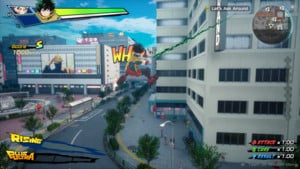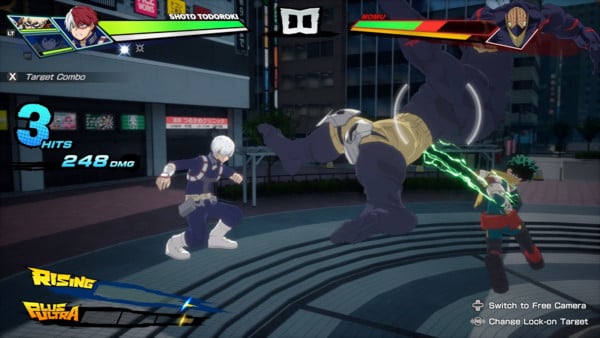Tokyo Game Show 2025
My Hero Academia: All's Justice Environment is the Real Star of the Game
by Ken Iikura-Gross,

This comes from the map being a recreation of a city you would see in My Hero Academia. Hence, we see things like shop signs, billboards, and even “help wanted” signs along with non-playable characters strewn about the mission world map—giving the game mode a real lived-in atmosphere.
What had me in awe about this mission map, though, were the interactions with the characters—along with one major billboard. Addressing the latter first, there is one billboard that features the top-ranking heroes from My Hero Academia. Yet, this billboard isn't static—rather, it's a facsimile of an electronic billboard. So, it cycles through a handful of professional heroes seen in My Hero Academia. It's a small touch, but it adds to the ambiance of My Hero Academia All's Justice.
The non-playable character dialog functions in a similar way. While not that important to the broader missions, characters talking about their daily lives adds a certain amount of relatable charm to My Hero Academia: All's Justice. It's almost like a life-simulator game in that regard and gives players the perspective of a My Hero Academia hero on the beat and talking with the locals.
To a similar degree, professional heroes and Class 1-A students dot the world map, and interacting with them adds a separate layer to the story presented in the Team-Up Mission mode. Rather than just dialog on a loop, though, players can do one of three interactions with the heroes or classmates. The options are a sub-mission (which is a separate mission entirely), challenging the character to a battle, or just talking to them. Each option grants a bonus to the score or a main mission buff, though which you receive depends on your choice. This is a great way to increase interactivity in the Team-up Mission mode and offers a certain amount of replayability.
Of course, the focus of My Hero Academia: All's Justice is the combat. The game has some new combat mechanics, such as the new “Rising” system and 3 vs 3 tag combat—but either because of my lack of familiarity with arena fighter games or the combat settings set to auto, it was difficult to parse out the difference between My Hero Academia: All's Justice and a game like Dragon Ball: Sparking Zero! More precisely, I found myself spamming the attack button rather than trying to engage with things like combos or blocking.

This is just my short, surface experience and shouldn't dissuade people from trying the game. The auto-attack setting is part of a modular system that allows players of all skill levels to enjoy the story, Team-up missions, and player-versus-computer enemy modes. My Hero Academia All's Justice also allows players to toggle between the auto attack mode and manual attack mode, giving the game some depth—just not the depth one would master in a short demo playthrough.
What I saw of My Hero Academia: All's Justice is fascinating. The Team-Up Mission mode I demoed has a well-crafted world map that feels as if it's teeming with life. And with so many interactions within it, you can get lost in exploring it. The mobility within the mission world map is fantastic—utilizing each character's quirks to get around the map faster. But, when it comes to the combat, it felt a bit lackluster. Again, I couldn't learn the intricacies of it in a short demo, but there is enough there to make you want to see what the battle system has to offer. I am also curious how the main story mode will tie into the final upcoming season of My Hero Academia—how the production team of My Hero Academia: All's Justice presents the story.
discuss this in the forum |
back to Tokyo Game Show 2025
Convention homepage / archives